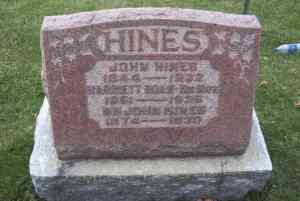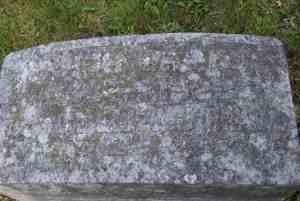I have found when researching my family, it is helpful to make a Family Timeline with all of the events and sources that I have gathered. As I find more sources and events, I add them to the timeline. This way, it is easier for me to see if there are any gaps that need to be researched and filled in.
For example, I am researching my Loyalist Haines family at the moment and have made a timeline for them. Since my two Loyalist ancestors are father and son, I have included both of them and included only my direct line. Joseph Haines, Sr. is proven to have descendants in the Loyalist Directory, but Nathaniel Haines hasn’t had any descendants proven yet, although his children are listed in The Loyalists in Ontario: The Sons and Daughters of the American Loyalists of Upper Canada. I guess I will be the first in the Nathaniel Haines family to prove descendancy.
Haines Family Timeline:
1750’s – Joseph Haines immigrated from Germany to Johnstown, New York. 28
>1783 – Joseph Haines, Sr. married and had seven children. 1
>1783 – Joseph Haines, Sr. and family lived in Johnstown, New York. 1, 28
>1783 – Joseph Haines, Sr. served in the Butler’s Rangers and went to Lachine, P.Q. with the rangers. 1
>1783 – Nathaniel Haines served in the Butler’s Rangers and went to Lachine, P.Q. with the rangers. 1
1784 – Joseph Haines, Sr. family was in Niagara, U.C. 35
1784 – Nathaniel Haines was in Niagara, U.C. 35
1786 – Joseph Haines, Sr. family was in Niagara, U.C. 1. 2
1786 – Nathaniel Haines was married in in Niagara, Upper Canada and received rations there. 1, 2
1792 – Nathaniel and Lydia Haines’ son, Andrew, was baptised at St. Mark’s Church, Niagara. 3
1796 -Joseph Haines, Sr. was granted a patent of land in Grantham Twp. in the Home district of U.C. 4
1796 – Nathaniel Haines was granted a patent of land in Grantham Twp. in the Home district. 4
1801 – Joseph Haines, Sr. and Peter Whitney purchased mill. 5
1811 – Nathaniel Haines died?
1818 – Philip Haines died in fire in York, U.C. 5, 6
1818 – Joseph Haines, Sr. deeded the mill to grandson, James Haines after his father, Philip Haines, died in a fire. 5
1818 – Joseph Haines, Sr. died.?
1835 – Benjamin Haines and Sarah Freisman were married in Niagara, U.C.?
1836 – Nathaniel’s son, Benjamin, is listed in the book, Sons and Daughters of American Loyalists and had an Order in Council as a SUE on Nov.3, 1836. 7
1837 – Benjamin Haines was granted land in Middlesex Cty.? 8
1844 – Feb. 23rd – Benjamin Haines’ son, John, was born in Niagara. 9, 24
1851- Benjamin Haines was living in Niagara Twp. with his wife and family. 9
1851- John Haines was in the 1851 census of the family. 9
1871 -Benjamin Haines was living in Aldborough Twp. Elgin Cty. 10
1872 – John Haines married Harriet Fernetta Doan in Welland, Ontario. 11
1881 – John Haines family was in the census of Welland. 12
1891 – Benjamin’s widow, Sarah Haines was in the census of Aldborough Twp., Elgin Cty. 13
1891 – John Hines family was in the census for Aldborough Twp., Elgin Cty. 14
1892 – Sarah Haines died in Rodney, Elgin Cty. 15
1894 – William Edgar Hines, was born in Aldborough Twp., Elgin Cty. 16
1897 – John Hines’ family moved to Essex County and were in Rochester. 17
1901 – John Hines family was in the census for Rochester, Essex County. 18
1906 – John Hines family were in Gosfield North Twp. in 1906 when their youngest daughter
died. 19, 20, 24
1911 – John Hines family were in Maidstone Twp. in the 1911 census. 21
1917 – Oct. 6 – William Edgar Hines married Josephine Desbiens and lived in Essex, Ontario. 22, 27
1926 – Aug. 14th -Earl Douglas Hines was born on Arthur Ave. in Essex. 23
1932 – March. 13th -John Hines died in Essex, Ontario. 24, 25
1935 – Dec. 2oth-Harriet Doan Hines died in Essex, Ontario. 25
1957 – Apr. 20th – Earl Hines married Marian Neil in Essex County, Ontario. 26
1958 -Sept. 30th – Earline Hines was born in Windsor, Ontario. 29
1964 – Earl Hines purchased property in Cottam, Ontario. 34
1976 – May 28th – Earline Hines was married to A. Morrison in Comber, Ontario. 30
1975 – Earl Hines sold property in Cottam and relocated to Leamington, Ontario.34
1977 – Mar. 29th – William Edgar Hines died in Essex, Ontario. 25, 32, 33
1977 – July 29th – B. Morrison was born in Leamington, Ontario. 29, 34
1979 – Jan. 22nd – K. Morrison was born in Leamington, Ontario. 29, 34
1983 – Earl Hines was divorced. 31
1984 – Earline Hines was divorced. 31
1985 – Mar. 9th – Earl Hines was married to R. Watkins Harris in Windsor, Ont. 34
1994 – July 4th – Josephine Hines died in Leamington, Ontario. 25, 32, 33
1996 – Feb. 7th – Earl Hines died in Windsor, Ontario. 25, 32, 33
2001 – June 2nd. – Earline Hines was married to R. P. Bradt in Leamington, Ontario. 30
2008 – Aug. 15th – Marian Neil Hines died in Leamington, Ontario. 32, 33, 34
Sources –
1. The Annotated Nominal Roll of the Butler’s Rangers 1777-1784 with Documentary Sources – Lieutenant Colonel William A. Smy, OMM, CD, UE
2. The Butler’s Rangers in the Revolutionary War – muster roll – E. Cruikshank
3. Baptisms at St. Mark’s Church transcribed by Bill Martin
4. Ontario People 1796-1803 – E. Keith Fitzgerald
5. The Economy of Upper Canada -Merchant Millers of the Humber Valley – Sydney Thomas Fisher
6. obituary – Death Notices of Ontario – W.D.Reid
7. The Loyalists in Ontario: The Sons and Daughters of the American Loyalists of Upper Canada-W.D.Reid
8. Canadian Digital Atlas Project
9. 1851 census Canada West, Niagara Twp, U.C.
10. 1871 census Aldborough Twp., Elgin Cty., Ontario
11. Ontario Marriage Records 1869-73- Ancestry
12. 1881 census Canada, Welland County, Ontario
13. 1891 Census Canada, Aldborough Twp., Elgin Cty.
14. 1891 Census Canada, Aldborough Twp., Elgin Cty.
15. Ontario Death Records – Ancestry
16. Ontario Birth Records
17. Ontario Birth Records – Fleming W. Hines – Jan. 18, 1897
18. 1901 Census Canada – Rochester Twp.
19. Ontario Death Records – Ancestry
20. Article in Essex Times 1906
21. 1911 Canada census Essex North
22. Ontario Marriage Records 1869-1924 – Ancestry
23. personal knowledge
24. Ontario Death records – Ancestry
25. Gravestone at Woodslee United Church Cemetery
26. Personal knowledge
27. Article in Essex Free Press, Oct. 1967 – 50th Wedding Anniversary
28. Loyalists Claims For Losses
29. Birth Certificate
30. Marriage License
31. Divorce Decree
32. Obituary
33. Funeral Card
34. present at event
35. The Centennial of the Settlement of Upper Canada by the United Empire Loyalists 1784-1884. – E.Ryerson
Now, it will be easier to find the documents that I need to copy and include in my certification application(s).
Filed under: Genealogy, ancestors, Haines, Haines Family Timeline, John Haines, Nathaniel Haines UEL, timeline, William Edgar Hines


















